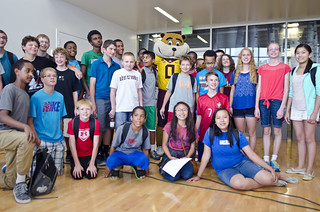In July, CTS introduced the next generation of the workforce to transportation topics and careers during a two-week summer program. Thirty students entering seventh through ninth grade attended the program, where they got hands-on experience with topics ranging from distracted driving to aeronautics to traffic management.
The CTS-hosted National Summer Transportation Institute is part of a national program designed to attract and introduce the brightest young minds from diverse segments of society to education and career opportunities in transportation. It was sponsored by CTS with funding from the Federal Highway Administration administered by the Minnesota Department of Transportation (MnDOT).
As part of the program, attendees toured campus, visited the U of M’s transportation-related labs, and learned tips on researching, studying, public speaking, and writing. In addition, participants learned about many aspects of transportation, including human factors, roadway safety, bridge design, surveying, and traffic simulation.

Camp slideshow (click for larger images)
Campers also had the chance to see transportation in action on a variety of field trips, including outings to several MnDOT facilities, UPS, Metro Transit, the Minneapolis–St. Paul International Airport, the Minnesota Transportation Museum, and boat tours of the St. Croix River Crossing construction site and St. Paul Port Authority.
Highlights for attendees included riding the light rail and going behind the scenes in a Metro Transit control room, watching airplanes take off and exploring maintenance equipment at the airport, getting up close to bridge construction on the St. Croix River Crossing boat tour, and using a driving simulator to learn about distracted driving at UPS.
“I really enjoyed using the driving simulators,” said one of the ninth-grade program participants. “It was a hands-on experience that truly taught me the dangers of texting while driving and how much harder it really is.”
Students also had the chance to apply what they learned to envision the future of transportation. As part of a group project, participants were asked to imagine what aviation, freight, transit, traffic engineering, and water transportation will look like in 2050. Students in each group presented their ideas—including things like self-driving hover vehicles, drones, and alternative fuels—at the program’s closing ceremony.
In post-program evaluations, parents reported that their children had learned valuable information about transportation topics, careers, and related education opportunities.
“This was one of the best camps we have ever experienced,” one parent said. “There was always a plan for college, and this program increased enthusiasm, preparedness, and maturity.”
“[The program] opened up my daughter’s horizon for future career choices and major focus areas after high school,” another parent said.
For other parents, lessons learned by students became evident on the car ride home.
“What a wonderful experience this camp was for my son,” said Jessica Findell, a parent of one of the seventh-grade students. “He was inspired...He learned about all kinds of traffic laws and data...and I now have a new back-seat driver.”



